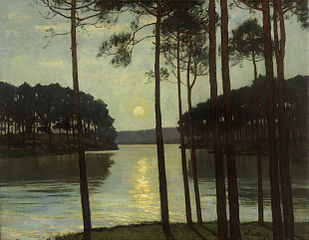Walter Leistikow
Walter Leistikow | |
|---|---|
 Walter Leistikow, portrait by Lovis Corinth, 1893 | |
| Born | Walter Rudolf Leistikow 25 October 1865 |
| Died | 24 July 1908 (aged 42) |
| Nationality | German |
| Education | Hermann Eschke, Hans Fredrik Gude |
| Movement | Berlin Secession |
Walter Rudolf Leistikow (1865-1908) was a German landscape painter, graphic artist, designer and art critic.
Biography[]
His father was a pharmacist who owned a Kräuterlikör manufacturing plant in Kujawien that provided much of the family's income. In 1883, aged seventeen, he moved to Berlin to attend the Prussian Academy of Art, but after barely one year, he was dismissed by Anton von Werner for lack of talent. He then took private lessons from Hermann Eschke and Hans Gude from 1885 to 1887.
His first exhibition was at the Berliner Salon in 1886 and, in 1892 he became a member of an artists' association known as Die-XI (), which was opposed to the teaching methods at the Academy. From 1892 to 1895, he taught at the private academy, Akademie Fehr, run by artist Conrad Fehr and located on Lützowstrasse 82 in Berlin.[1] He also designed furniture, carpets and wallpapers. In 1902, he was chosen to create trading cards for the Stollwerck chocolate company of Cologne and produced a series of German landscapes.[2]
For a time, he tried to become a writer, publishing a novella called Seine Cousine (1893) in the Freie Bühne and a novel, Auf der Schwelle (1896), but they received little attention.[3] To make matters worse, Kaiser Wilhelm II despised his pictures and was quoted as saying "er hat mir den ganzen Grunewald versaut" (he has ruined the entire Grunewald for me).[4]
In 1894, he married Anna Mohr (1863-1950), a merchant's daughter from Copenhagen. In 1903, he was one of the co-founders of the Deutscher Künstlerbund.[5]
By 1908, he was dying from the agonizing effects of advanced-stage syphilis. He committed suicide by shooting himself while staying at the Sanatorium Hubertus on the Schlachtensee. Shortly after, a street in Berlin's Westend district was named after him.[6] In 1920, a street in the Mahlsdorf district was named after him as well. He was later given an ehrengrab at the cemetery in Steglitz. A commemorative stamp was issued in 1972, with one of his paintings of the Schlachtensee .
Selected paintings[]

In the Grunewald

Liebesinsel, Havel

Evening Mood on the Schlachtensee

House in Denmark
References[]
- ^ Zieger, Angela (2 May 2019). "Ich bereite vor: Eine Ausstellung nach meinem Tode.": Zum grafischen, malerischen und kalligrafischen Werk von F.H. Ernst Schneidler. ISBN 9783947449323.
- ^ Detlef Lorenz: Reklamekunst um 1900. Künstlerlexikon für Sammelbilder. Reimer, Berlin 2000, ISBN 978-3-496-01220-7.
- ^ Walter Leistikow: Auf der Schwelle. Schuster & Loeffler, Berlin 1896. / als Reprint: Arzneimittel-Verlag, Berlin 2008, ISBN 978-3-921687-32-1.
- ^ Clark, Christopher (6 September 2007). Iron Kingdom: The Rise and Downfall of Prussia, 1600-1947. Penguin Books. p. 691. ISBN 978-0-141-90402-3.
- ^ kuenstlerbund.de: Ordentliche Mitglieder des Deutschen Künstlerbundes seit der Gründung 1903 / Leistikow, Walter (Vorstandsmitglied) Archived 2017-02-24 at the Wayback Machine
- ^ Leistikowstrasse in Kauperts Straßenführer durch Berlin
- Klaus Merx (1985), "Leistikow, Walter", Neue Deutsche Biographie (in German), 14, Berlin: Duncker & Humblot, pp. 163–164; (full text online)
Further reading[]
- Ernst Schur: Walter Leistikow. In: Berliner Architekturwelt, 11. Jahrgang, Nr. 6 (September 1908), pgs.213–215.
- Lovis Corinth: Das Leben Walter Leistikows. Ein Stück Berliner Kulturgeschichte. Paul Cassirer, Berlin 1910
- Margrit Bröhan: Walter Leistikow – Landschaftsbilder. Ars Nicolai, Berlin 1994 ISBN 978-3-894799-01-4
- Markus Nass: Walter Leistikow. Das druckgraphische Werk. Galerie Gerda Bassenge, Berlin 1999, ISBN 3-00-004140-0
- Ingeborg Becker (Ed.): Stimmungslandschaften. Gemälde von Walter Leistikow. Exhibition catalog, Deutscher Kunstverlag, Berlin/München 2008, ISBN 978-3-422-06829-2
External links[]
| Wikimedia Commons has media related to Walter Leistikow. |
- ArtNet: More works by Leistikow.
- Literature by and about Walter Leistikow in the German National Library catalogue
- Works by and about Walter Leistikow in the Deutsche Digitale Bibliothek (German Digital Library)
- Ausstellung Die Welt will Grunewald von mir. mit Bildliste (PDF; 448 kB) seit 19. Oktober 2012 im Bröhan-Museum, Berlin
- 1865 births
- 1908 deaths
- People from Bydgoszcz
- 19th-century German painters
- 19th-century male artists
- German male painters
- 20th-century German painters
- 20th-century male artists
- People from the Province of Posen
- German landscape painters
- Artists who committed suicide
- 1908 suicides



